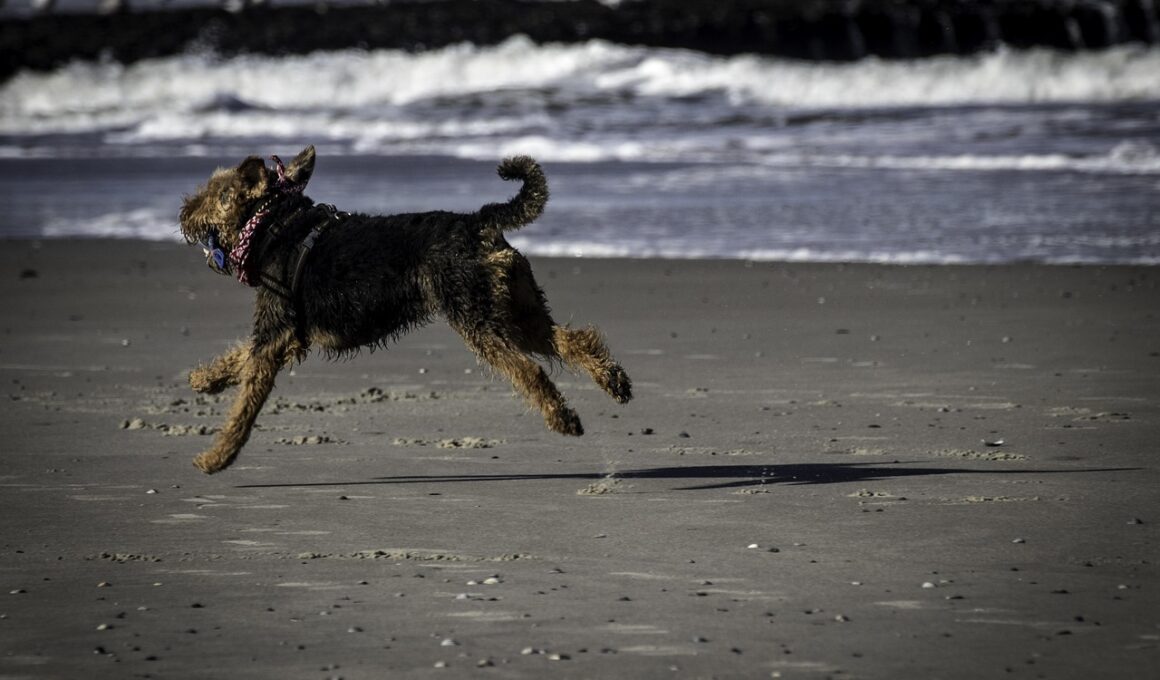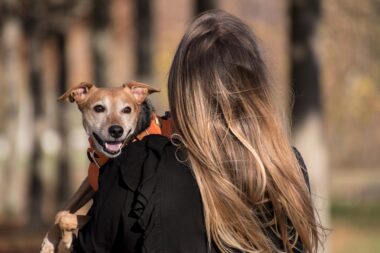Adjusting Dog Exercise During Travel and Vacations
When planning travel, it’s essential to consider your dog’s exercise needs. Dogs, similar to humans, thrive with regular activity. During vacations, maintaining a routine can help prevent behavioral issues. Make adjustments that suit your travel itinerary while keeping your pet’s health in check. Identifying ideal times to exercise keeps dogs mentally and physically stimulated. Morning and evening align well with cooler temperatures, allowing for comfortable outdoor excursions. Gradually adapting their routine may ease the transition into new environments. Instead of lengthy walks, consider shorter but more frequent outings. The frequency creates opportunities for your dog to socialize and explore. Plan rest stops during long journeys to accommodate your pet. Engage them in activities at these stops, ensuring they consume enough fresh water and have opportunities for bathroom breaks. Incorporate fetching or tug-of-war into downtime. Such activities will help release pent-up energy. Remember to reflect on your dog’s age, breed, and health while adjusting their exercise routine. Consult a veterinarian if you have concerns about specific exercises. Dogs of different breeds may require varying amounts of exercise daily, so customizing routines is key.
Another important aspect of keeping your dog active while traveling is adapting to new locations. Exploring parks or pet-friendly hiking trails can provide your dog with the necessary exercise. Local parks often have open areas to run, making them perfect for exercise sessions. Ensure that any park or trail you visit is dog-friendly and has suitable amenities. Bringing your dog’s favorite toys can make these experiences even more exciting. Chew toys or balls can enhance playtime in unfamiliar surroundings. Set a consistent schedule for exercise times, mimicking home routines. It can offer a sense of stability amidst the change. If staying at a hotel or rental, inquire about pet policies and nearby exercise options. Some places may have designated pet areas. Engaging with local dog owner communities, perhaps through social media, can also provide recommendations for dog parks. These interactions are beneficial for meeting local dogs. Consider utilizing mobile apps dedicated to finding dog-friendly spaces. Be mindful not to overexert your dog, especially in higher temperatures than they are accustomed to. Introduce new outdoor experiences gradually, allowing your dog to acclimate to varying terrains.
Maintaining Exercise Routines
During vacations, it’s crucial to maintain your dog’s exercise routine while being adaptable. Make use of early mornings or late afternoons for walks, as temperatures tend to be cooler, especially in summer. Exploring beaches or lakes during off-peak hours allows pets to enjoy themselves in a safe environment. Dogs appreciate new sights and sounds; hence, exchanging familiar paths for novel routes can be refreshing. However, maintaining a balance is essential, ensuring both novelty and consistency in their exercise patterns. Good leash training remains a priority, particularly in public spaces to ensure safety. Dogs should remain well-behaved, which helps to avoid conflict with other dogs or travel stress. Using a comfortable leash or harness can make walks more enjoyable for both of you. As your trip progresses, consider varying activities, such as teaching your dog new tricks or engaging them in agility exercises during breaks. Keep sessions short yet frequent. This variety stimulates their minds and bodies, enhancing their overall experience. A well-exercised dog is often more relaxed in social situations, which helps during the travel workflow. Fun games can serve as incredible alternatives when space is limited.
Equipment also plays a role in fulfilling your dog’s exercise needs during travels. Packing essential gear makes excursions effortless and efficient. Bring a collapsible water bowl to keep your pet hydrated on-the-go. Consider portable food containers for easy access to snacks or meals. Many dog-friendly products enhance their comfort while traveling. For instance, a comfortable dog bed encourages relaxation at any location. A compact harness or leash setup contributes to ease during outings. Furthermore, be cautious about unfamiliar environments; new scents may excite or overwhelm your dog. Be mindful of their behavior for any signs of stress or discomfort, such as panting or reluctance to walk. Gradually introducing your dog to new surroundings can alleviate their anxiety. Train them prior to your travels, emphasizing positive reinforcement for good behavior. This can develop their confidence in unfamiliar settings. Never leave your dog unattended in new places, especially sunny areas; overheating poses a serious risk. Pets require supervision to ensure their safety and comfort. Adjusting your dog’s travel schedule to include regular exercise will ultimately create enjoyable memories together.
Staying Safe While Exercising
Safety should remain a priority wherever you travel with your dog. Research potential hazards in your destinations that may affect your pet. Different locations might have unfamiliar wildlife, weather patterns, or terrain types. Inspect parks for any restrictions and stay updated on leash laws in public areas. Ensure your dog’s collar and tags are secure. Consider investing in a GPS tracker for your dog; it can be invaluable in case of a lost pet. During outdoor activities, be cautious about temperature, especially during hot months. Dogs are susceptible to heatstroke if overexerted and improperly hydrated. Always carry water while on outings to prevent dehydration. Identifying shady spots to rest can reduce the risk of overheating. Watch for signs of exhaustion in your dog, such as excessive panting or drooping ears. Additionally, as your dog engages in new activities, paws may become sensitive to harsh surfaces. If hiking, pack dog-friendly booties to protect their feet. This investment is beneficial for rough terrains or extreme weather conditions. Furthermore, familiarize yourself with the nearest veterinary services, just in case emergencies arise. Knowing local resources enhances safety during travels.
Another consideration while traveling is the interaction with other dogs. Socialization plays a crucial role in your dog’s exercise, yet it’s essential to supervise these encounters. Unfamiliar dogs can sometimes show aggression or fear, prompting reactive behavior. Be prepared to handle such situations calmly to prevent unnecessary conflict. Always observe body language cues from other dogs in public spaces. Consider avoiding crowds of engage in activities with a smaller group. Play sessions with other friendly dogs can be beneficial for their physical and mental stimulation. Arrange for playdates if staying longer in one area. Many communities have Facebook groups or apps dedicated to local dog owners; these platforms can help find playmates. Promoting healthy interactions will ease your pet into various social situations, further enhancing overall travel experiences. Always reward good behavior after successful encounters, reinforcing positive habits. Create buffer zones in social situations where both dogs can assess each other without pressure. This adjusted speed helps reduce anxiety and tension. Training remains essential, especially when encouraging calmness during these encounters. Patience during social situations ultimately results in well-rounded experiences for both your dog and yourself.
Conclusion and Final Tips
In conclusion, adjusting your dog’s exercise habits during travel and vacations requires thoughtful planning and flexibility. By maintaining a consistent schedule that incorporates local adventures, you nurture their physical health and emotional well-being. Ultimately, the goal is to create memorable experiences that strengthen the bond between you and your pet. Remember to prioritize safety, especially when navigating through unfamiliar environments. Making use of local pet facilities and activities enhances socialization, which proves beneficial for your canine companion. Each outing presents an opportunity for learning and excitement. Keep your travel plans realistic and consider your dog’s needs—ideal times for exercise may differ based on regional climate. Don’t hesitate to seek advice from fellow travelers on dog-friendly hotspots and trails. Additionally, always maintain an open mind toward adjusting your schedules as you encounter unexpected situations. Every adventure is a learning experience, both for you and your dog. With patience and preparation, your travel experiences can become delightful and fulfilling. The joy of exploring new places together will significantly enrich your travel adventures and create lasting memories. Embrace each day as a new opportunity for laughter, play, and discovery.
As a reminder, keeping your dog active and engaged during vacations is essential to their well-being. Through early planning and adapting exercise routines, you can achieve a balance that reinforces stability amid the excitement. Enjoy these shared travel experiences with your furry friend, ensuring that both you and your dog return home energized and happy. Happy travels!





